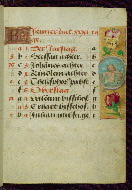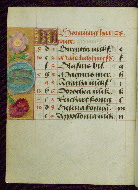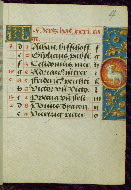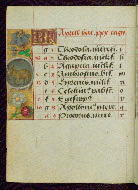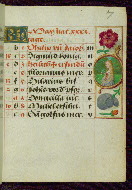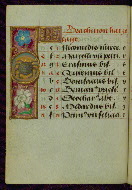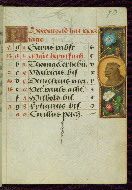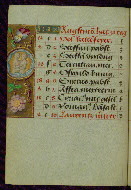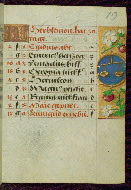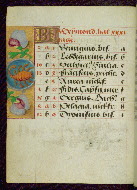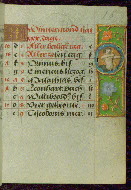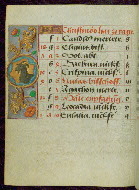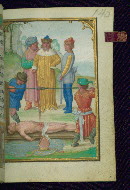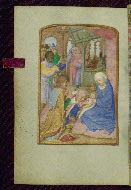Home > Digitized Walters Manuscripts
This document is a tranformation of a TEI P5 XML manuscript description incorporating images. If you have trouble reading special or non-Latin characters on this page, please make sure you have appropriate Unicode fonts installed and an up-to-date web browser.
Walters Ms. W.426, Prayer Book
Browse images (Browse images in a new window) | TEI in XML format
W.426
Prayer Book
This Prayer Book, likely completed in Bruges ca. 1510-20, contains eight extant full-page miniatures, twelve calendar illustrations, and ten illuminated margins. The artistic style is similar to that of Simon Bening, but its relationship to him has not been firmly established. It is a small devotional text, sized to fit easily into the palm of the supplicant. The book is bound in violet velvet with ornate, chiseled silver-gilt furnishings and has a kid-lined violet velvet case for further protection and decoration. As for the devotional content of the Prayer Book, this manuscript is at first striking for its multilingual prayers; the text alternates between mostly German and Latin prayers, although the last section of the book, a part that remains unfinished, is written in French. Contents are indicative of an intended German owner, but there remain some Netherlandish feasts with irregular dates. Although diminutive in size, this manuscript is rich in content, heritage, and decoration.
Ca. 1510-1520 CE
Bruges(?)
Supplied name: Simon Bening (?) and associates
Book
Devotional
The primary language in this manuscript is Latin. The secondary languages of this manuscript are German, French, Middle (ca.1400-1600).
Parchment
Thin parchment, of excellent selection and preparation; slightly thicker parchment for illuminated folios; front flyleaves i-iii ruled, date ca. sixteenth century(?) so likely postdate book's original binding; front flyleaf i affixed to modern parchment, matching doublure with blue calf joint added by last binder
Foliation: iii+208+2 bis folios+i
Two folios were missed during foliation, resulting in 2 bis folios, which were labeled at the time fols. 152A and 152B; therefore there are actually 210 folios in the manuscript. Modern pencil foliation upper right corners rectos
Formula: Unascertainable due to tight binding; composition in quires of eight, first recto on hair-side as indicated by extant catchwords
Catchwords: Catchwords in brown ink at lower right, in cursive on fol. 73v, the rest in text hand: fols. 30v, 39v, 47v, 55v, 67v, 73v, 140v, 177v
Signatures: Signature "C3" in pale brown ink at lower left on fol. 9 (now quire 2), suggests removal of first quire marked with the "a" series
Comments:
6.0 cm wide by 7.6 cm high
3.2 cm wide by 3.9 cm high
- Columns: 1
- Ruled lines: 11
- Layout does not apply to calendar: written surface 3.9 x 3.9 cm, 5 columns, 11 lines
- Title: Prayer Book
- Hand note: Written in textura
- Decoration note: Twelve calendar illustrations, zodiacal signs in roundels at or above center in border panel at fore-edge on the first of the two rectos occupied by each month; eight extant full-page miniatures, patently relevant accompanying text at six openings (fols. 22v, 56v, 60v, 134v, 146r), less obvious connection at two others (fols. 31v and 161v); ten borders, two of which are figural; of varying types, none around extant miniatures, rich and varied on facing text pages (see fol. 32r for an exceptionally undecorated border), border decoration on two pages indicated original juxtaposition with two miniatures that are now lost (see fols. 90 and 137); decorated illuminated intials at major text openings, at secondary text openings, and "KL" in calendar; borders of liquid gold: in calendar, panel at fore-edge; inhabited borders opposite miniatures on fols. 22v, 56v, 161v; illusionistic gold-ground borders opposite one lost and three extant miniatures (respectively fol. 90r and fols. 135r, 144r, 145v; line fillers are few in number, panel type in dark red outlines, slightly more abundant and in paler hies in second portion of the volume; rubrics in red; text in dark brown ink
- Title: Calendar
- Rubric: Jenner hat xxxi tage
- Contents: Major feasts in German, graded in red and black; emphasis on German saints; diagrams and tables; prayers in Latin; saints' names as a rule in Latin with appended German designations, selection emphasizes Bamberg diocese; consecutive alphabets in outer column at right of feasts, keyed to computistic tables; contents indicate destination for a German owner, mixture of Netherlandish feasts, some dates irregular, feasts of note include: Telephorus (Jan. 5, "Thelephorus pabst.," Hamburg), John II (Jan. 11, "pabst.," regularly Jan. 12), Brigid (Feb. 1, "Birgitta iunckfraw.," cf. Jun. 1), Richard (Feb. 7, "Reichart konig"), Polichronius (Feb. 17, "politronus bis."), Frederic (Mar. 5, "peichti[ger]," bishop of Utrecht), Gumbert (Mar. 2, "ritter;" rich Franconian knight, Benedictine abbot; regularly Mar. 20, relics at Ansbach, Benedictine monastery, diocese of Würzburg), Henry (Mar. 13, "keyser;" king and emperor, d. 1024, Bamberg, etc., cf. Jul. 14), Zacharius (Mar. 14, "prophete."), Theodosia (Apr. 2; alternatively Apr. 1 and Apr. 3), Hegesippus (Apr. 7, "Egesipp[us]," no designation, Utrecht), Adalbert (Apr. 24, "adelbertus bis[scof]," regularly Mar. 23 or Mar. 25), William (May. 28, "hertzo[g]") Deochar (Jun. 7, "abt.," first abbot of Hasenrie [Herrieden] in Franconia), Henry (Jul. 14; Brandenburg, etc.; cf. Mar. 13), Afra (Aug. 7), Sebaldus (Aug. 19, Bamberg, etc.), Kunegundis (Sept. 9, "erhebung:' Translation, Bamberg; Franciscan tertiary, niece of St. Elizabeth of Hungary, d. 1279), Otto and Jerome (Sept. 30, no designations; Otto: bishop of Bamberg, died there in 1139), Maximilian (Oct. 12, bishop), Coloman (Oct. 13, d. 1012), Hedwig (Oct. 15, "erwelt," d. 1243), Cordula (Oct. 22, no designation), Radegundis (Oct. 24, "koni[gin];" feast regularly Aug. 13),Emeric (Nov. 4, "hertzog," d. 1031; Bamberg), Livin (Nov. 12, "Leuinus biss.," bishop, Flanders, relics brought to Ghent 1007), Conrad (Nov. 26, bishop of Constance), Sola (Dec. 3, "abt.," abbot, Eichstädt, Fulda), Agatho (Dec. 7, "mertr," martyr; pope in 678-81), Hermogenus (Dec. 12, "mer."), Theodosia (Dec. 22, Freising, Hamburg, Utrecht, etc.); added early on fol. 18v in left margin beside "Der christag": Anastasia (Dec. 25); other entries in margins fully or partly effaced on fols. 1v, 9r, 17v, and 18r
- Decoration note: Calendar illustrations include zodiacal signs, interchanged for May and August; illustrations on right fore-edge for months beginning on the recto of a folio, illustrations on left fore-edge for months beginning on the verso of a folio
- Title: Two computistical diagrams and three tables
- Contents: Two computistical diagrams dated 1501 and three tables; fol. 19r: Circular diagram of dominical letters centered on page in black ink; fol. 19v: Circular diagram of golden numbers set as on fol. 19r; fol. 20r: Advent table in Latin and German; fols. 20v-21r: table of zodiacal signs in column at far left, lunar effects below as "Bonu[m]" in red and "malu[m]" in black, keyed to alphabet in calendar at right of feasts; fol. 21v: table for weeks between Christmas and Quinquegesima
- Title: Devotional Sequence
- Rubric: Ad sancte trinitatis patre oratio
- Incipit: Domine sancte pater
- Contents: Fols. 23r-26r: Three prayers, one to each member of the Trinity; fols 26r-27r: Suffrage to the Trinity, two prefatory cues, antiphon, versicle, responsory, collect; fols. 27r-28r: Two prayers to God and Christ, the first for recitation on rising and at other times, second citing Three Magi by name; fols. 29r-v: Prayer to Christ, for recitation before going to sleep; fols. 30r-32r: Prayer in praise of Christ, "N" for name of suppliant and syllables of sacred words by gold cross on colored panel; fols. 32r-34v: Prayer for God's mercy, revealed to St. Augustine by the Holy Spirit according to heading, "Oratio sancti augustini a spiritu sancto sibi revelata. Deus propitius esto michi peccatori & custodi me. sis mecum omnibus diebus . . . ."; fols. 34v-43r: Prayer for God's help in a just cause; fols. 43r-47r: Prayer for remission of sins and good life's end for oneself, friends, and enemies; fols. 47r-48r: Prayer for a good life's end: "Oratio pro bono fine. In manus inextinguibilis charitatis * misericordie tue pater sancte pater iuste et amantissime commendo spiritum meum . . . ."; fols. 48v-49r: Prayer to Christ, attributed to in heading to St. Bernard: "Oratio sancti bernardi ad ihesum. O bone ihesu duo in me cognosco. naturam quam tu fecisti . . . ."; fols. 49r-51r: Prayer to Christ, yielding Indulgence for twenty-thousand days, purported in heading to have been composed by Pope Innocent VI (Boniface VIII intended?) at request of King Philip of France, for recitation at Communion Mass between elevation of the Host and third "Agnus dei", "Quicumque sequentem orationem inter elevationem corporis christi et tercium agnus dei devote dixerit consequitur indulgentiam viginta milium dierum concessa a domino Innocentio papa sexto. ad supplicationem * instantiam domini regis francorum Philippi christianissimi. Domine ihesu christe qui hanc sacratissimam carnem de gloriosa virgine maria assumpsisti . . . ."; fols. 51r-55v: three prayers on the Passion, yielding Indulgence of remission of all sins granted by Pope Innocent III (1160-1216) when read or recited at certain times during Mass; fols. 55v-59v: Three prayers to Christ, associated in heading with chapel of the Holy Cross in Rome, devout reading said to yield maximum Indulgences; fols. 59v-86r: Devotions to the Virgin, granting Indulgences specified in headings; fols. 59v-70r: Prayer, three-hundred days of Indulgence granted by unspecified Pope Innocent for devout reading; fols 70r-72v: Prayer said to have been revealed to St. Bernard by an angel, rhyming, daily devout recitation provides safeguard against unconfessed death (cf. fols. 83v-84v); Prayer said to be as precious as gold, most precious of all metals, "Quicumque sequentem orationem quotidie devoe dixerit sine penitentia et misterio corporis christi non decedet. sicut fertur revelatum fuisse beato bernardo cui ab angelo data est. qui et dixit. sicut aurum est preciocissimum genus omnium metallorum sic et ista oratio preciosior est ceterum de domina orationibus. Ave maria ancilla trinitatis humillima (sic for "humilissima"). Ave maria preelecta dei patris filia, sublimissima. Ave maria sponsa spiritus sancti . . . ."; fols. 72v-73v: Prayer for devout recitation before image of Virgin of the Sun (Rev. 12:1), yielding eleven-thousand years of Indulgence granted by Sixtus IV (d. 1484); fols. 73v-75r: Prayer to the Virgin, termed "golden" in heading (cf. fols. 70r-72v), rhyming, rubricated opening words spell out angel's salutation to the Virgin Annunciate; fols. 75r-77r: Prayer on Seven Corporeal Joys of the Virgin, seven verses; fols. 77r-80r: Prayer on Seven Spiritual Joys of the Virgin, seven verses; fols. 80r-83r: Lament of the Sorrow of the Virgin by the Cross, rhyming, devout recitation said to yield seven years of Indulgence and forty "karens," as granted by unspecified pope Boniface: "Sequitur planctus beate Marie, quem qui corde devoto recitaverit septem annos indulgenciarum obtinebit. et xl karenas a bonifacio papa. Stabat mater dolorosa. iuxta crucem lacrimosa . . . ."; fols. 83v-84v: Prayer praising merits of the Virgin, devout recitation prevents unconfessed death (cf. fols. 70r-72v), "Quicumque sequentem orationem qualibet die devote dixerit meritis beate marie sine vera penitencia & confessione peccatorum suorum non morietur. Mater digna dei venie via luxque diei. Sis tutela mei duxque comesque mei . . . ."; fols. 84v-86r: Suffrage to the Virgin, for protection at time of death and salvation from plague, two antiphons, the first rhyming, "Ad beatam mariam virginem contra pestem antiphona. Stella celi extripavit primus parens hominum . . . ."; fols. 86v-87v: Prayer to the Cross; fols. 87v-89v: Prayer ascribed to Pope John XII (955-64), reading text when passing church or cemetery said to yield as many days of Indulgence as number of buried corpses of faithful Christian; collect cites "N" for name of the deceased, "Sequentem orationem compilavit pap Iohannes xii. concedens cuilibus transeunti cimiterium vel ecclesiam & orationem eandem devote legenti. tot died indulgentiarum. quot christi fidelium corpora ibi sunt sepulta. Auete omnes christi fideles anime. det vobis requiem ille qui est vera requies . . . "
- Decoration note: Full-page miniatures on fols. 22v, 31v, 56v, and 60v
- Title: Devotional Sequence in German
- Rubric: Vorbereittung andechtiglich mes zw
- Incipit: Here ihesus criste der die weltt
- Contents: Devotional sequence, in German, by different scribe; fols. 90r-96r: Communion prayers, the first citing numerous saints beginning with Peter, the Magdalene, Afra (twice, especially revered in Augsburg); fols. 98v-100r: Suffrage to God for absolution, opening antiphon followed by three versicles, two collects; fols. 100r-105r: Seven Last Words of Christ, each utterance preceded by gold cross on red or blue panel, followed by prayer on the Passion with analogously marked divisions; fols. 105r-113r: Prayer invoking members of the Trinity, Virgin; fols. 113v-116v: Prayer to Christ on his martyrdom; fols. 116v-119r: Prayer to Christ, Indulgences of 18,000 years; fols. 119v-120v: Prayer to Christ; fols. 120v-121r: Five Verses of St. Gregory, each headed by numbered "vater unsser"; fols. 123v-132r: two prayers to the Virgin, the second with versicle and collect; fols. 132r-133v: Prayer to Christ
- Hand note: By different scribe
- Decoration note: Loss of miniature before Communion prayers indicated by ornamented border on opening text page of fol. 90r
- Title: Suffrages
- Rubric: Ein antiffen vonn sant Cristoffell. dem heiliger mertrer gottes
- Incipit: O wie gar verdienst
- Contents: Suffrages to four male saints and one female saint, the last indicates change of design; fols. 133v-136v: Christopher; fols. 136v-138r: Michael; fols. 138r-139r: John Baptist; fols. 139r-142v: John Evangelist; fols 142v-143v: Catherine, fols. 143r blank; fols 144r-145r: Suffrage to St. Catherine in full, repeats text on fol. 142v, by different scribe; fols. 145v-151v: Prayer St. Erasmus; two blank and ruled folios, skipped in modern foliation (fols. 152a and 152b)
- Decoration note: Full-page miniatures on fols. 134v, 143v, 146r, and 162v; loss of miniature before Suffrage to St. Michael indicated by ornamented border on opening text pages of fol. 137r
- Title: Devotions to St. Brigid of Sweden
- Rubric: Das leben sant Brigitte
- Incipit: Es ist gewesen ein andechtige
- Contents: Devotions to St. Brigid of Sweden (d. 1373); fols. 153-160v: Prefatory account including references to saint's life span (1341-73), her canonization by Boniface IX (1391), Christ's compliance with her request before image of crucifix to know the number of his wounds (cited on fol. 154v: 5460); recitation of prayers that follow said to yield forgiveness of sins and forty-day Indulgence, closing reference to salvation of SS. Peter and Paul; fols. 161r-162v: Prayer to St. Brigid; fols. 162v-195r: Fifteen O's of St. Brigid, for recitation with repeat of closing prayer to Christ; spaces for headings at times left blank, other headings give cues and the number of the prayer within the group; fols. 193r-194r: Closing prayer
- Title: Seven Penitential Psalms
- Incipit: Les sept pseaumes penitentiaux
- Text note: Added, ca. seventeenth century, in French; heading indicates Seven Penitential Psalms, of which only the first psalm is transcribed with a prefatory antiphon "Les sept pseaume penitentiaux / Antienne / Seigneur / ne vous resourvenez point / pseaume 6. / Seigneur ne me reprenez point dans vostre fureur . . . ."; fols. 195v-208v: blank, ruled
fol. 1r:
fol. 2v:
fol. 4r:
fol. 5v:
fol. 7r:
fol. 8v:
fol. 10r:
fol. 11v:
fol. 13r:
fol. 14v:
fol. 16r:
fol. 17v:
fol. 22v:
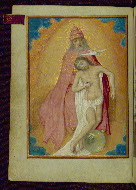
- Title: Trinity: Throne of Grace
- Form: Full-page miniature
- Text: Devotional Sequence: Prayers to the Trinity
fol. 31v:
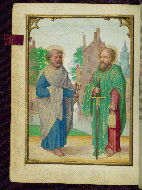
- Title: SS. Peter and Paul
- Form: Full-page miniature
- Text: Devotional Sequence: Prayer, "Deus propitius esto michi"
fol. 56v:
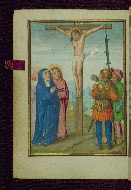
- Title: Crucifixion
- Form: Full-page miniature
- Text: Devotional Sequence: Prayer, "Domine ihesu christe"
fol. 60v:
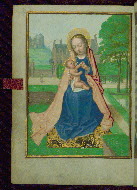
- Title: Virgin and Child in garden
- Form: Full-page miniature
- Text: Devotional Sequence: Prayer, "O clementissima domina"
fol. 134v:
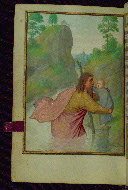
- Title: St. Christopher prepares to lift Christ-Child standing on shore
- Form: Full-page miniature
- Text: Suffrages: St. Christopher
fol. 143v:
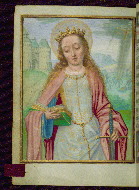
- Title: St. Catherine reading, explosion of martyrdom wheel in background
- Form: Full-page miniature
- Text: Suffrages: St. Catherine
fol. 146r:
fol. 161v:
The binding is not original.
French(?), ca. nineteenth century; violet velvet; sewn on three cords, spine rounded and backed, hollow; modern endbands in yellow and green silk; gilt edges, gauffered after cropping, pointiellé single and double linear frame design; chiseled and ornate silver gilt furnishings, central medallion and corner-guards probably German, ca. second half of the sixteenth century; modern side plates in form of Pan-herms (head of the upper Pan-herm missing) and engraved fore-edge clasps with fret decoration hinged from lower cover; blue silk ribbon marker, leather fore-edge tabs; worn velvet case, violet in color, front flap with missing button, inside of case lined in kid
Ca. 1510-20, Bruges(?); completed in the style of Simon Bening (1483-1561, recorded in Bruges as of 1508), possibly relevant inscription in border of fol. 61r
Owned by two women ca. 1518-47; owners' entries in Calendar in lower margin, fully or partially effaced, dates and names of two women still legible on fol. 9r, "1518" and fol. 1r, "1522 . . . katharina"
Jan Kommer, sixteenth or seventeenth century, signature entered on fol. 208, possibly former back pastedown
Léon Gruel, Paris bookbinder and bookseller, late nineteenth or early twentieth century, his unnumbered slip removed from front pastedown
Henry Walters, Baltimore, purchased from Gruel between 1895 and 1931
Walters Art Museum, 1931, by Henry Walters' bequest
De Ricci, Seymour, and W. J. Wilson. Census of Medieval and Renaissance Manuscripts in the United States and Canada. Vol. 1. New York: H. W. Wilson Company, 1935; p. 810, cat. no. 332.
Wolf, Edwin. A Descriptive Catalogue of the John Frederick Lewis Collection of European Manuscripts in the Free Library of Philadelphia. Philadelphia: 1937; Fig. 44.
Walters Art Museum, D. Miner. Illuminated Books of the Middle Ages and the Renaissance: An Exhibition Held at the Baltimore Museum of Art. Baltimore: 1949; no. 214, Pl. LXXVIII
Walters Art Gallery. The History Of Bookbinding, 525-1950 A.D. Organized by the Walters Art Gallery and Presented in Cooperation with the Baltimore Museum of Art. Baltimore: Trustees of the Walters Art Gallery. 1957, no. 122
Flanders in the Fifteenth Century: Art and Civilization. Catalogue of exhibition entitled "Masterpieces of Flemish Art: van Eyck to Bosch," Detroit Institute of Arts and the City of Bruges: Detroit and Brussels, 1960: no. 213, illus.
Diringer, David. The Illuminated Book: Its History and Production, rev. ed. New York: 1967; p. 455.
Dogaer, Georges. "La travéebrugeoise dans quelques manuscrits de l'école Ganto-Brugeoise." Scriptorium 23 (1969): 338-341; p. 340
Biermann, Alfons W. "Die Miniaturenhandschriften des Kardinals Albrecht von Brandenburg (1514-1545)," Aachener Kunstblätter 46 (1975); pp. 29-31.
Verbeke, W. “Kroniek der handschriftenkunde in de Nederlanden - Studie van de middeleeuwse handschriften uit de Nederlanden (nrs. 2518-2635).” Archief- en bibliotheekwezen in België 56 (1985): 394-455; p. 410.
Dogaer, Georges. Flemish Miniature Painting in the 15th and 16th Centuries. Amsterdam, B.M. Israël, 1987; p. 177.
Randall, Lilian M. C. Medieval and Renaissance Manuscripts in the Walters Art Gallery. Vol. 3. Belgium, 1250-1530. Baltimore and London: Johns Hopkins University Press in association with the Walters Art Gallery, 1989; pp. 521-531 (ref. under cat. no. 296, W. 426)
Owens, M. B. "Musical Subjects in the Illumination of Books of Hours from Fifteenth-Century France and Flanders," Ph.D. dissertation, University of Chicago: 1987, p. 471
Kren, Thomas. “Simon Bening and the Master of the David Scenes in the Grimani Breviary.” In Illuminating the Renaissance: The Triumph of Flemish Manuscript Painting in Europe. Edited by Thomas Kren and Scot McKendrick, 448-449. Los Angeles: J. Paul Getty Museum, 2003; p. 449, ref. under cat. no. 139.
As-Vijvers, Anne Margreet W. “Weaving Mary’s Chaplet: The Representation of the Rosary in Late Medieval Flemish Manuscript Illumination.” In Weaving, Veiling, and Dressing: Textiles and Their Metaphors in the Late Middle Ages. Edited by Kathryn M. Rudy and Barbara Baert, 41-80. Turnhout: Brepols, 2007; p. 77.
Goehring, Margaret L. “The Representation and Meaning of Luxurious Textiles in Franco-French Manuscript Illumination.” In Weaving, Veiling, and Dressing: Textiles and Their Metaphors in the Late Middle Ages. Edited by Kathryn M. Rudy and Barbara Baert, 121-155. Turnhout: Brepols, 2007; p. 153.
Principal cataloger: Randall, Lilian M.C.
Cataloger: Herbold, Rebekah
Editor: Herbert, Lynley
Copy editor: Dibble, Charles
Conservator: Quandt, Abigail
Contributors: Emery, Doug; Herbold, Rebekah; Noel, William; Tabritha, Ariel; Toth, Michael B.; Wiegand, Kimber
The Walters Art Museum
Licensed for use under Creative Commons Attribution-ShareAlike 3.0 Unported Access Rights, http://creativecommons.org/licenses/by-sa/3.0/legalcode. It is requested that copies of any published articles based on the information in this data set be sent to the curator of manuscripts, The Walters Art Museum, 600 North Charles Street, Baltimore MD 21201.
